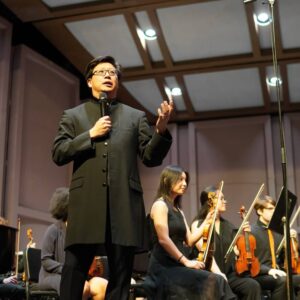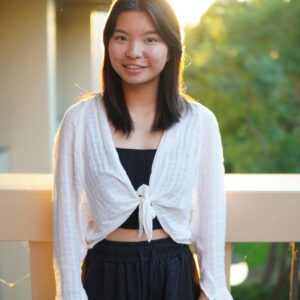
The Occidental Symphony Orchestra held its first concert of the year Nov. 11 in Thorne Hall, capturing the audience’s attention and crafting a musical narrative with a diverse repertoire. The concert featured four orchestral pieces of music, including compositions by Felix Mendelssohn, Samuel Coleridge-Taylor, Fanny Mendelssohn and student-composer Timothy Shortell (senior).
According to music professor and Director of Instrumental Music Chris Kim the orchestra music program selects qualifying students of music composition to be resident composers and write an orchestral piece for the annual concerts.
“We have a wonderful faculty member, Adam Schoenberg, who teaches all these very talented undergraduate composers,” Kim said. “I’ve asked Adam to identify a student composer who is ready to write a piece for the orchestra.”

Kim said that for the Fall concert, the department selected Shortell, a music composition major, and he composed a 12-minute orchestral piece titled “Colliding Worlds.” Shortell said that he started writing the piece directly after speaking with music directors last Spring.
“I spent a lot of time trying to come up with a concept and structure for the piece because I knew that there was a lot I wanted to include,” Shortell said. “I wanted some more intimate small sections with different soloists featured on different instruments, but I also wanted it to get very huge and epic.”
Shortell said that he developed the concept of colliding worlds to properly cover the proportions of his musical idea, which is structured in three parts that flow into each other under their common theme.
“The first [section] is two people meeting each other and falling in love — so metaphorically their worlds collide. From there, it expands in scale to societies and cultures colliding — and there’s an intense battle section,” Shortell said. “The final section of the piece is literal planets colliding and that’s where I went all out — everyone in the orchestra and choir is playing at full volume and [it is] the massive cataclysmic finale.”
The section leader for violin, Zerlina Lai (senior), said that the “Colliding Worlds” piece is very cinematic in its grandeur.
“It feels like it’s a whole journey,” Lai said. “There’s some softer, more vulnerable moments in the music that are super nice. And then it’s followed by a big contrast where you get driven, high energy.”
According to Shortell, the piece included around 90 musicians — with approximately 55 orchestra members and 35 Occidental Glee Club members. Shortell said he incorporated the vocal aspect to make the music sound larger than life. Additionally, the piece included an electric guitar and electric bass to amplify the sound, according to Shortell.
“In the later part of the piece where we go to the idea of planets colliding — it gets more futuristic sounding, so I wanted to bring in some more modern instruments,” Shortell said.

Marie Mawji, associate production manager for performing arts facilities, said “Colliding Worlds” was particularly memorable for her, as she’s seen the orchestra become a robust program in the last few years.
“You can tell that [Shortell] threw everything into it,” Mawji said. “Having the Glee Club was really special. The piece wasn’t your typical classical type [of] music, it was really different and original and unique.”
Suzan PourSanae, a community member from Culver City, said she heard about the concert from a friend and greatly enjoyed the performance. She said she was particularly moved by Shortell’s piece and found personal meaning in it, and thought it captured many global conflicts occurring now.
“I really loved the theme of colliding worlds because I think it’s very appropriate to what’s happening in our world today,” PourSanae said. “It dealt with the micro — which is relationships — to societies and cultures colliding.”
In addition to “Colliding Worlds,” the concert featured three more orchestral pieces — Kim said he’s particularly interested in exploring lesser-trodden musical repertoire. The show included “The Bamboula” by Samuel Coleridge-Taylor, a BIPOC composer, according to Kim.
“[‘The Bamboula’] is music that should be played and should be heard, and the students are loving playing that piece,” Kim said. “I’m really fortunate to be able to work on music that interests me and that interests our students.”
Visiting assistant music professor Alexander Zhu, who was in the audience of the show, said he appreciated the concert’s programming and setlist.
“It’s so great to hear representation of women composers and composers of color, as well as student-composed works,” Zhu said. “This is the first time I’ve heard the piece by Samuel Coleridge-Taylor and I can’t believe we don’t hear it more in standard repertoire — it’s so great.”
Kim said that the piece by Fanny Mendelssohn, “Overture in C,” is one of her only purely orchestral works that she’s written out of almost 500 pieces for voice and piano. According to Kim, Fanny Mendelssohn is often overlooked because of her brother, Felix Mendelssohn.
“When you say Mendelssohn, most people think of Felix. And we are playing an overture by Felix Mendelssohn, but it’s sort of a double bill — you get a Fanny and Felix Mendelssohn in this concert,” Kim said.
According to Kim, “Hebrides Overture” by Felix Mendelssohn was written after the composer visited Fingal’s Cave — a massive, alien-looking sea cave. Kim said that visiting the cave affected [Felix] Mendelssohn so much that he wrote the “Hebrides Overture” in response to the experience of nature.
“Oftentimes when we’re rehearsing ‘Hebrides Overture,’ I find myself making analogies to places like the surging of waves — water coming in and out — so the tempo has to surge forward and then relax,” Kim said. “That imagery is really helpful.”
The audience was captive in listening while the orchestra performed the piece on stage. Lai, who’s played in many orchestras as a violinist, said that “Hebrides Overture” was a highlight for her.
“I like it because it feels like a rush of water,” Lai said.

PourSanae said the Fall concert was the second time she had visited Occidental’s campus, and that she hopes to go to more Occidental music performances in the future.
“I am so impressed with this music program,” PourSanae said. “To have a student conductor is kind of unbelievable — it’s the first time I’ve seen something like this and I’ve been to a lot of university and college performances. So, kudos to Occidental.”
Kim said that the orchestra has a strong sense of community as they work towards the collective goal of their concerts. According to Kim, music is used to express ideas that can’t be fully captured in words.
“Whether it be Felix Mendelssohn, Fanny Mendelssohn, Samuel Coleridge-Taylor or Timothy Shortell, we’re trying to find ways to be expressive with our emotions and communicate with another human being through music,” Kim said. “I think people find a lot of joy in being able to make music with each other and sharing with the community.”
Contact Julian Villa at jvilla@oxy.edu
![]()


































